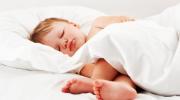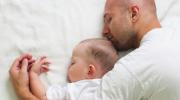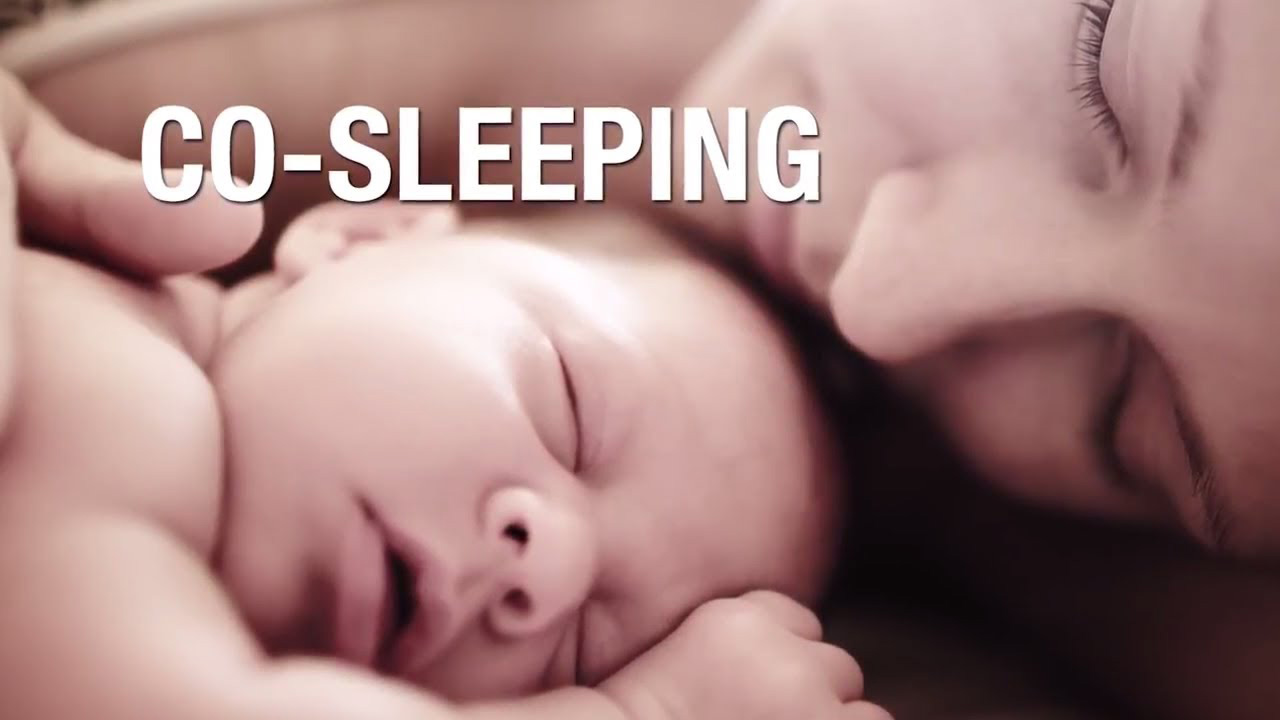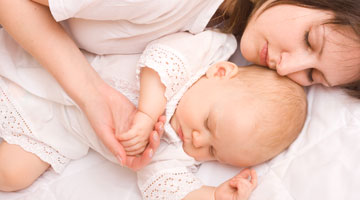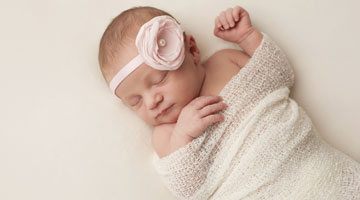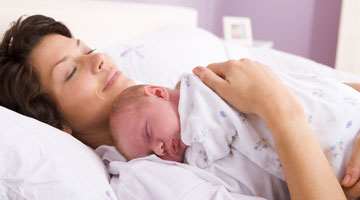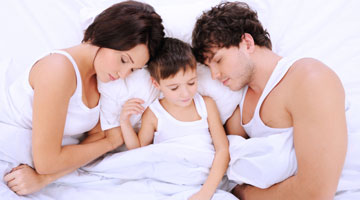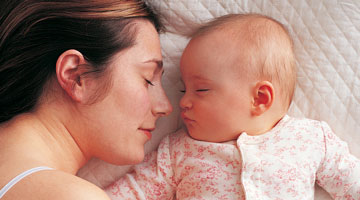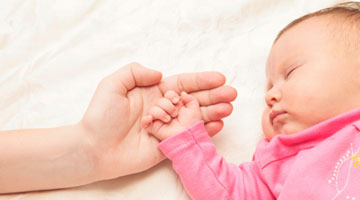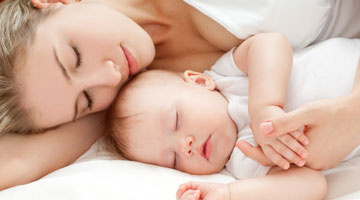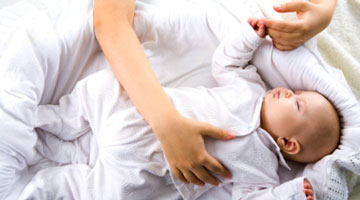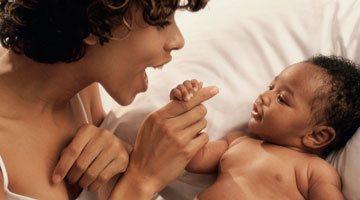�� explains anthropologist Dr. James McKenna, PhD, who is recognized as the world’s leading authority on mother-infant co-sleeping.
Co-sleeping is part of the attachment parenting philosophy, a style of parenting that emphasizes physical, emotional, and psychological closeness between parent and child.
Benefits of co-sleeping
Advocates of co-sleeping with bed-sharing believe that with the proper safety precautions, a newborn is better off– and in fact safer–when sleeping beside the mother.
“Babies should not sleep alone. The safest baby is a breastfeeding baby in the family bed,” says Dr. Jay Gordon, MD, FAAP, IBCLC, a member of the Professional Advisory Board of La Leche League for 24 years.
Spending so much time close together will increase the mother’s sensitivity to her baby’s needs, allowing her to sense where her baby is and when it will need something.
“We learn that over 60% of mothers’ brief awakenings occur plus or minus two seconds after the baby has aroused, and similarly we learn that about 40% of the babies’ arousals have occurred plus or minus two seconds after the mother has aroused,” says McKenna, author of Sleeping with your baby: A parent’s guide to co-sleeping.
These arousals are said to reduce the risk of Sudden Infant Death Syndrome (SIDS) because they keep the baby from entering a deep sleep. SIDS is thought to occur when babies experience a pause in breathing, or apnea, and are in too deep of a sleep to re-regulate their breathing. Additionally, a mother who is in tune with her baby’s sensory signals may be able to sense if their child has stopped breathing or is functioning abnormally.
Proponents of co-sleeping with bed-sharing attribute this increased awareness of their baby’s wellbeing to mothers getting more restful sleep.
“[Co-sleeping] can also mean better sleep for everyone, which is a huge, huge plus because your baby never really has to wake up fully crying in order to get your attention. She stirs, you sense her, you immediately respond to her needs. That means she goes back to sleep easier, you go back to sleep easier. Much less stress for everyone,” says therapist Aimee Wheeler, PsyD, founder of the Parenting Discovery Center.
Those in favor of co-sleeping with bed-sharing believe the its benefits also include:
Being aligned with human nature, history, and biology.
“When you think about babies as evolutionary beings, you have to remember that for the bulk of our time on the planet, to not be sleeping with your parent meant to be in a perilous situation,” explains Wheeler. “So it’s important to remember what it is that your baby is biologically wired to need. They need to be close to you during the night to feel a sense of safety.”
Breast milk production can increase.
The motor that drives milk production is the removal of milk, so the more often a mother breastfeeds, the more her body will produce milk, according to lactation specialist Corky Harvey, MS, RN, IBCLC, co-founder of Pump Station & Nurtury. Bed-sharing allows for more frequent breastfeeding because not only is the baby already beside the mother, but the mother does not have to get up to get the baby and can sleep while she breastfeeds.
An important mother-child bonding experience.
“There is a great mother and child bond while you have the child so close to you,” says Helena Heyman, a literary manager and co-sleeping mother of three. This is especially important for working mothers who might not get as much time with their babies during the day.
“One thing that bed-sharing serves to do is to permit mothers to validate their role as mothers,” says McKenna, who notes that working mothers in his experience have felt inadequate at bonding and creating attachment.
Physiological regulation.
McKenna says bed-sharing can also have a mutual regulatory effect on the mother and baby’s heart rate, breathing patterns, apnea patterns, blood pressure, and hormone production.
“There is an entire cascade of hormonal events that affect the mother, such as the production of Oxytocin and Prolactin precipitated by the fact that her baby is breastfeeding more frequently. Similarly, insofar as the baby’s body is concerned, the production of estrogen and neurotransmitters are completely affected,” says McKenna.
More breastfeeding means more oxytocin, which lowers stress levels and can make a woman more calm and relaxed in the long run.
But not everyone agrees.
“The American Academy of Pediatrics recommends room-sharing when you have a new baby, but not bed-sharing. We know that co-sleeping is one of the many risk factors for SIDS, or sudden infant death syndrome,” says Dr. Tanya Altmann, MD, FAAP, a leading medical authority, parenting expert, and media spokesperson.
While advocates for bed-sharing believe it reduces the risk of SIDS because of the increased sensitivity it can produce for a mother, those opposed say the risk of suffocation from bed-sharing outweighs the potential for that benefit.
According to Dr. Harvey Karp, author of The Happiest Baby on the Block, an estimated 70% of infants who die in their sleep during the first year of life die in an adult bed. Karp believes this is in part due to how exhausted parents are during their first year with a newborn.
“50% of parents are sleeping less than 6 hours a night. When you do that week after week and you did it at the end of pregnancy, you are the equivalent of drunk,” says Karp.
Not only does this impair your judgment and ability to function, but the sleep you do get will be deeper than usual. This combination, Karp says, is one which leaves your newborn at risk.
Other risks of bed-sharing are said to be:
- Softer bed surface and more items in the bed, such as pillows and sheets, that can accidentally suffocate an infant.
- Parents accidentally rolling onto the child in their sleep, especially if intoxicated.
- Falling out of the bed.
- Older siblings in the bed as well, especially toddlers, who may not understand how fragile the newborn is or be as aware of the newborn in their sleep as a parent will be.
- Gaps between the headboard and mattress.
Doctors and experts that warn against bed-sharing recommend using a bassinet or co-sleeper very close to the mother’s bed, so that their needs can easily be perceived and met, but their sleep is in a protected environment.
Doctors across the board agree that cribs, bassinets, and all infant sleep environments should be free of loose blankets, pillows, stuffed animals, and toys. Babies should be placed on their backs to sleep and the sleep surface should be firm with only a fitted sheet.
“Kids cannot protect themselves. They cannot push a toy away if it is blocking their airway, so you put nothing in their crib or bassinet when they are sleeping,” advises Dr. Nina Shapiro, MD, director of Pediatric Otolaryngology at the David Geffen School of Medicine at UCLA.



